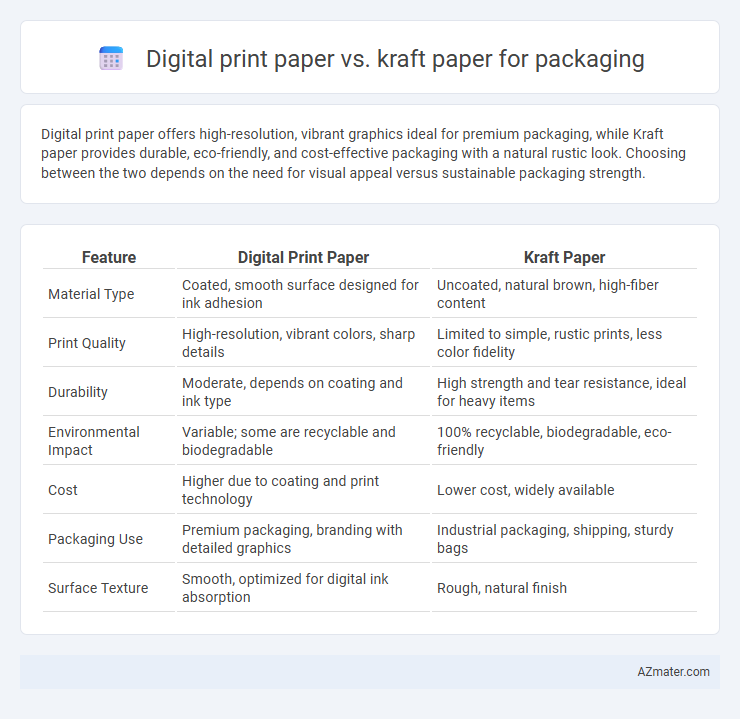Digital print paper offers high-resolution, vibrant graphics ideal for premium packaging, while Kraft paper provides durable, eco-friendly, and cost-effective packaging with a natural rustic look. Choosing between the two depends on the need for visual appeal versus sustainable packaging strength.
Table of Comparison
| Feature | Digital Print Paper | Kraft Paper |
|---|---|---|
| Material Type | Coated, smooth surface designed for ink adhesion | Uncoated, natural brown, high-fiber content |
| Print Quality | High-resolution, vibrant colors, sharp details | Limited to simple, rustic prints, less color fidelity |
| Durability | Moderate, depends on coating and ink type | High strength and tear resistance, ideal for heavy items |
| Environmental Impact | Variable; some are recyclable and biodegradable | 100% recyclable, biodegradable, eco-friendly |
| Cost | Higher due to coating and print technology | Lower cost, widely available |
| Packaging Use | Premium packaging, branding with detailed graphics | Industrial packaging, shipping, sturdy bags |
| Surface Texture | Smooth, optimized for digital ink absorption | Rough, natural finish |
Introduction to Packaging Materials
Digital print paper offers high-resolution graphics and vibrant color reproduction ideal for customized packaging, while kraft paper provides superior durability and eco-friendly properties suitable for heavy-duty and sustainable packaging solutions. Packaging materials play a critical role in product protection, brand presentation, and environmental impact, with digital print paper enhancing visual appeal and kraft paper excelling in strength and recyclability. Choosing between these materials depends on packaging requirements such as print quality, durability, and sustainability goals.
What is Digital Print Paper?
Digital print paper for packaging is a specially coated paper designed to produce high-quality, vibrant digital prints directly from printers, offering sharp images and rich colors essential for product branding. It enables faster turnaround times and customization without the need for traditional printing plates, making it ideal for short runs and prototype packaging. Compared to Kraft paper, which is known for its durability and natural brown appearance, digital print paper emphasizes print clarity and graphic detail to enhance visual appeal.
Understanding Kraft Paper
Kraft paper offers high durability and resistance to tearing, making it ideal for heavy-duty packaging and eco-friendly applications. Its natural brown color and unbleached fibers provide a rustic, organic aesthetic favored for sustainable branding. Unlike digital print paper, Kraft paper excels in strength and recyclability, supporting environmentally conscious packaging solutions.
Comparing Aesthetic Appeal
Digital print paper offers vibrant colors and detailed graphics that enhance the visual impact and brand identity of packaging, making it ideal for high-end or promotional products. Kraft paper provides a rustic, natural aesthetic with its textured, earthy tones, appealing to eco-conscious consumers seeking authentic and minimalistic designs. Both materials serve distinct market needs, with digital print paper excelling in customization and kraft paper favored for sustainability-driven packaging.
Durability and Strength
Digital print paper offers moderate durability suitable for lightweight packaging but lacks the tensile strength and tear resistance of Kraft paper. Kraft paper, made from wood pulp using the sulfate process, provides superior strength and durability, making it ideal for heavy-duty packaging applications. Its natural fibers enhance structural integrity, ensuring protection during transportation and handling.
Sustainability and Eco-Friendliness
Digital print paper for packaging often incorporates recycled fibers and soy-based inks, reducing environmental impact through lower energy consumption and less chemical waste during production. Kraft paper, made from natural wood pulp with minimal processing, offers superior biodegradability and compostability, making it highly sustainable for eco-conscious packaging solutions. Both materials support sustainable practices, but Kraft paper's recyclability and renewable sourcing typically provide a stronger eco-friendly advantage for packaging applications.
Cost-Effectiveness Analysis
Digital print paper offers high-quality graphics and customization capabilities suitable for premium packaging but tends to be more expensive due to advanced printing technology and ink costs. Kraft paper provides a durable, eco-friendly option with significantly lower material and production expenses, making it ideal for cost-effective bulk packaging solutions. Evaluating total cost-effectiveness involves balancing digital print paper's visual impact against Kraft paper's affordability and sustainability benefits.
Customization and Branding Opportunities
Digital print paper offers superior customization and branding opportunities compared to kraft paper due to its high-resolution printing capabilities and ability to reproduce vibrant colors, intricate designs, and detailed logos. Brands can leverage digital print paper to create unique, eye-catching packaging that enhances product visibility and consumer engagement, while kraft paper's natural brown texture limits color options and detailed graphics. Custom packaging on digital print paper supports dynamic branding campaigns and personalized packaging, elevating brand identity and market differentiation.
Ideal Use Cases for Each Paper Type
Digital print paper excels in packaging applications that require high-resolution graphics, vibrant colors, and detailed branding, making it ideal for luxury or retail products that demand visual appeal and customization. Kraft paper is best suited for eco-friendly, durable packaging needs such as shipping boxes, grocery bags, and industrial wrapping, valued for its strength, recyclability, and rustic aesthetic. Brands focusing on sustainability and cost-effectiveness often prefer kraft paper for bulk packaging, while those prioritizing marketing impact and intricate designs opt for digital print paper.
Choosing the Right Packaging Paper for Your Brand
Digital print paper offers high-resolution graphics and vibrant color reproduction, making it ideal for brands seeking eye-catching, customizable packaging. Kraft paper provides durability, eco-friendliness, and a natural, rustic aesthetic, appealing to environmentally conscious consumers and brands emphasizing sustainability. Selecting the right packaging paper depends on your brand's design priorities, environmental values, and the packaging's functional requirements.

Infographic: Digital print paper vs Kraft paper for Packaging
 azmater.com
azmater.com